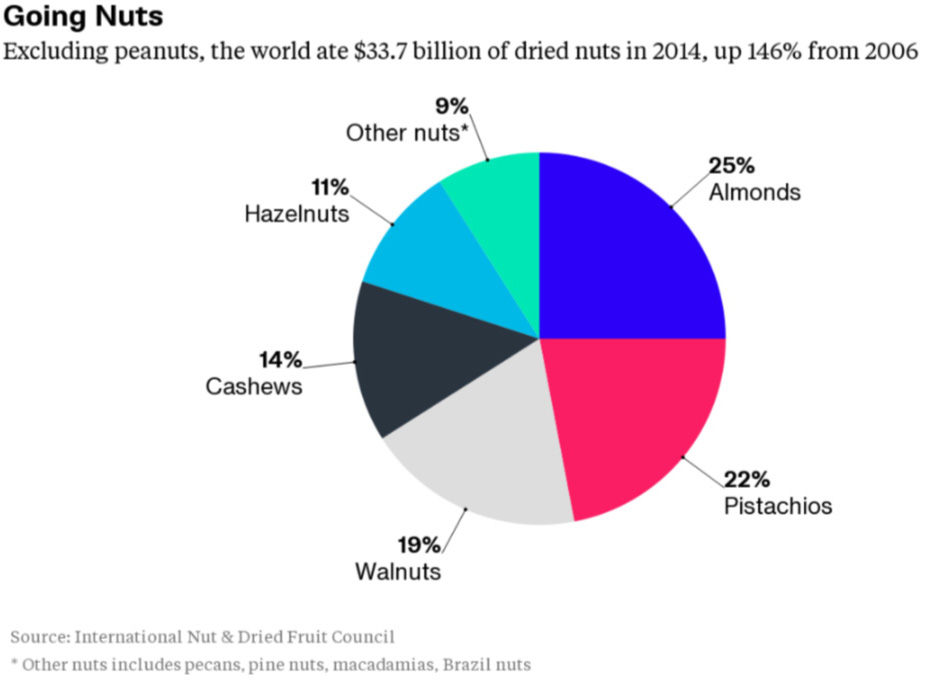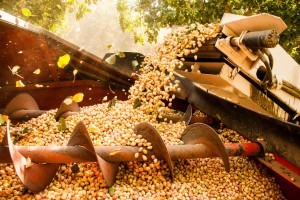Pistachios
The pistachio, a member of the cashew family that Plantations International grows in Greece, is a small tree originating from Central Asia and the Middle East.The pistachio tree produces seeds that are widely consumed as food. Pistacia vera often is confused with other species in the genus Pistacia that are also known as pistachio. These other species can be distinguished by their geographic distributions (in the wild) and their seeds which are much smaller and have a soft shell.
Pistachio Habitat
Pistachio is a desert plant, and is highly tolerant of saline soil. It has been reported to grow well when irrigated with water having 3,000–4,000 ppm of soluble salts. Pistachio trees are fairly hardy in the right conditions, and can survive temperatures ranging between −10 °C (14 °F) in winter and 48 °C (118 °F) in summer. They need a sunny position and well-drained soil. Pistachio trees do poorly in conditions of high humidity, and are susceptible to root rot in winter if they get too much water and the soil is not sufficiently free-draining. Long, hot summers are required for proper ripening of the fruit. They have been known to thrive in warm, moist environments.
Pistachios Characteristics
The bush grows up to 10 m (33 ft) tall. It has deciduous pinnate leaves 10–20 centimeters (4–8 inches) long. The pistachio plants are dioecious, with separate male and female trees. The flowers are apetalous and unisexual, and borne in panicles. The fruit is a drupe, containing an elongated seed, which is the edible portion. The seed, commonly thought of as a nut, is a culinary nut, not a botanical nut. The fruit has a hard, creamish exterior shell. The seed has a mauvish skin and light green flesh, with a distinctive flavor. When the fruit ripens, the shell changes from green to an autumnal yellow/red, and abruptly splits part way open (see photo). This is known as dehiscence, and happens with an audible pop. The splitting open is a trait that has been selected by humans. Commercial cultivars vary in how consistently they split open.
Each pistachio tree averages around 50 kilograms (110 lb) of seeds, or around 50,000, every two years. The shell of the pistachio is naturally a beige color, but it is sometimes dyed red or green in commercial pistachios. Originally, dye was applied by importers to hide stains on the shells caused when the seeds were picked by hand. Most pistachios are now picked by machine and the shells remain unstained, making dyeing unnecessary except to meet ingrained consumer expectations. Roasted pistachio seeds can be artificially turned red if they are marinated prior to roasting in a salt and strawberry marinade, or salt and citrus salts. Like other members of the Anacardiaceae family (which includes poison ivy, sumac, mango, and cashew), pistachios contain urushiol, an irritant that can cause allergic reactions.
Introduction of Pistachio Cultivation
Pistachios are grown for its edible nuts and pistachio tree is a small to medium sized tree with a branching main stem and a spreading growth habit. It can reach up to 20 feet height in wild conditions and up to 10 feet in cultivated conditions. Pistachio is one of the culinary nuts grown in most of the countries and belongs to the cashew family. These nuts are the lowest calorie of the nuts, but they are rich in phytosterols, antioxidants, unsaturated fat, carotenoids, vitamins and minerals and fiber. It is uncertain where pistachio nut trees originated but probably originated from Middle East and Central Asia. Pistachios belong to the family of “Anacardiaceae and genus of “Pistacia”. Basically pistachio trees are either male or female. However, both are required to produce a crop. Usually the nuts are produced on the female trees where as male trees provide the pollen to fertilize the female tree flowers. Pistachio trees take longer time to get into production stage. Pistachio nuts have excellent demand both locally and internationally. One can obtain decent profits if they are grown in right climate by following good pistachio farming practices.
Health Benefits Pistachio Nuts
- Pistachios are heart friendly nuts
- Pistachios are good source of vitamins and minerals.
- Pistachios are low calorie nuts, hence aids in weight management.
- Pistachios help in reducing the risk of age related macular disease.
- Pistachios help in eliminating skin dryness.
- Pistachios are good source of dietary fiber and aids in digestion.
- Pistachios have Aphrodisiac and Antioxidant properties.
- Pistachios protects from getting diabetes.
- Pistachios help in absorption of iron from food.
- Pistachios help in decreasing the LDL (bad cholesterol) level in blood.
Climate Requirements
Weather condition is most important factor in growing pistachio crop. These nut trees prefer day temperatures above 36 °C and winter months cold enough to complete their dormant period 7 °C. These trees don’t grow well in high elevations due to the cool temperatures. In India, Jammu & Kashmir is natural location to grow pistachio nuts.
Soil Requirements
Pistachio tress can be grown in wide range of soils. However, they prefer well- drained deep sandy loam soils. These trees are quite drought tolerant but don’t do well in areas where high humidity is possible. Soil test would be helpful, if you are planning pistachio production on large scale. Pistachio trees will produce quality nuts with high yields where soil pH is kept at a range of 7.0 to 7.8. These trees are hardy ones which can tolerate higher alkalinity to certain extent.
Land Preparation
When it comes to preparing the land in pistachio cultivation, the process should be similar to other nut crops. Soil should be chiselled, ploughed and disked to obtain the soil fine tilth stage. If any hardpan is found in the top 6 to 7 feet of soil, it should be broken as pistachio trees are deep rooted in nature and these trees are affected by water stagnation.
Pistachio Propagation
Pistachio trees are usually propagated by budding on to a suitable pistachio rootstock. These rootstock (seedlings) can be raised in nurseries. Usually, budding is carried out in fall with and the budded trees are being planted the same year or the following year depending on the size of the rootstock (seedling).
Pistachio Planting and Spacing
As part of the planting, dig the holes large enough to accommodate the roots. Generally, the Pistachio trees should be planted 1 inch lower than it was raised in nurseries or containers. When it comes to plant spacing, it depends on irrigation. In case of irrigated gardens, plants should be spaced at 6 meter * 6 meter for grid pattern. In areas where irrigation is not available, trees can De spaced at 8 meter * iu meter. For bearing Pistachio nuts, both male and female trees should De planted in the ratio of 1:8 (one male and eight female trees) to 1:10 (one male and ten female trees).
Pistachio Irrigation Requirements
Though Pistachio tress are drought tolerant, they should De maintained with enough moisture whenever needed. Mulching is the best practice to retain the water. Drip irrigation can be adopted for proper utilization of water. Avoid any water logging conditions. Rainy season don’t need any irrigation.
Manures and Fertilizers
As nitrogen is important fertilizer for any nut crop, pistachios trees have a similar nitrogen requirement just like other nut trees. However, fertilizers should not be applied in the first year of planting but in the subsequent year. Each pistachio tree should be provided with 450 grams of ammonium sulphate in 2 split doses during the growing season. In later years, actual nitrogen (N) of 45 kg to 65 kg per acre should be provided. Nitrogen should be applied in 2 splits doses over the growing season.
Intercultural Operations
Pistachio trees should be trained to grow upward and outward direction and develop into a modified open-vase shape. The center of the tree should be kept open to admit sunlight for better flower formation and fruit set, which might be needed by the 4th or 5th winter season. Secondary branches should be removed as part of thinning operation. Once the tree framework has been established, only minor pruning cuts should be needed. Weed control is another task in pistachio production for healthy growing of trees and producing quality nuts. Make sure to clean the space between trees as the weeds compete for nutrients. Herbicide treatments should be mainly used for the berms and are applied pre-emergent and/or post-emergent. Mulching the trees controls weeds as well as retains the water content in the soil.
Pests and Diseases
Mites, Stinkbug and Leaf-footed plant bug are the common insect pests found in Pistachio production. Powdery mildew, Rust, Alternaria late blight, Armillaria root rot, Crown gall, Pistachio dieback, Septoria leaf spot, Panicle and shoot blight, Pistachio psyllid and Pistachio twig borer are some of the diseases found in pistachio cultivation. For symptoms and control measures, contact your local horticulture
Note: Contact your local department of horticulture for pests and disease symptoms and their control. They are the best source for control solutions in pistachio cultivation.
Harvesting Pistachios
Pistachio trees take longer time to produce nuts. These budded trees become ready to produce fruits for 5 years and will not reach maximum production until the 12th year of planting. ( Pistachio trees begin bearing the 5th year after budding. However, a significant crop is not harvested until the seventh or eighth season. The first full production year starts occurring around 12th year only). The easy identification of maturity is when the hull separates easily from the shell. Generally, this period extends for 6 to 10 days. Care should be taken while harvesting by avoiding underdeveloped kernels.
Pistachio Crop Yields
Yield of the Pistachio nuts mainly depends on climate , cultivar (variety) and crop management practices. On an average a yield of 8 to 10 kg per fully matured tree (After 10 to 12 year of budding) can be obtained.
To find out more about how Plantations International can assist you with the development and management of your own Pistachio crop and to receive a free initial consultation, please call us today on +852 5808 3775 or Click Here to contact your nearest Plantations International representative.


